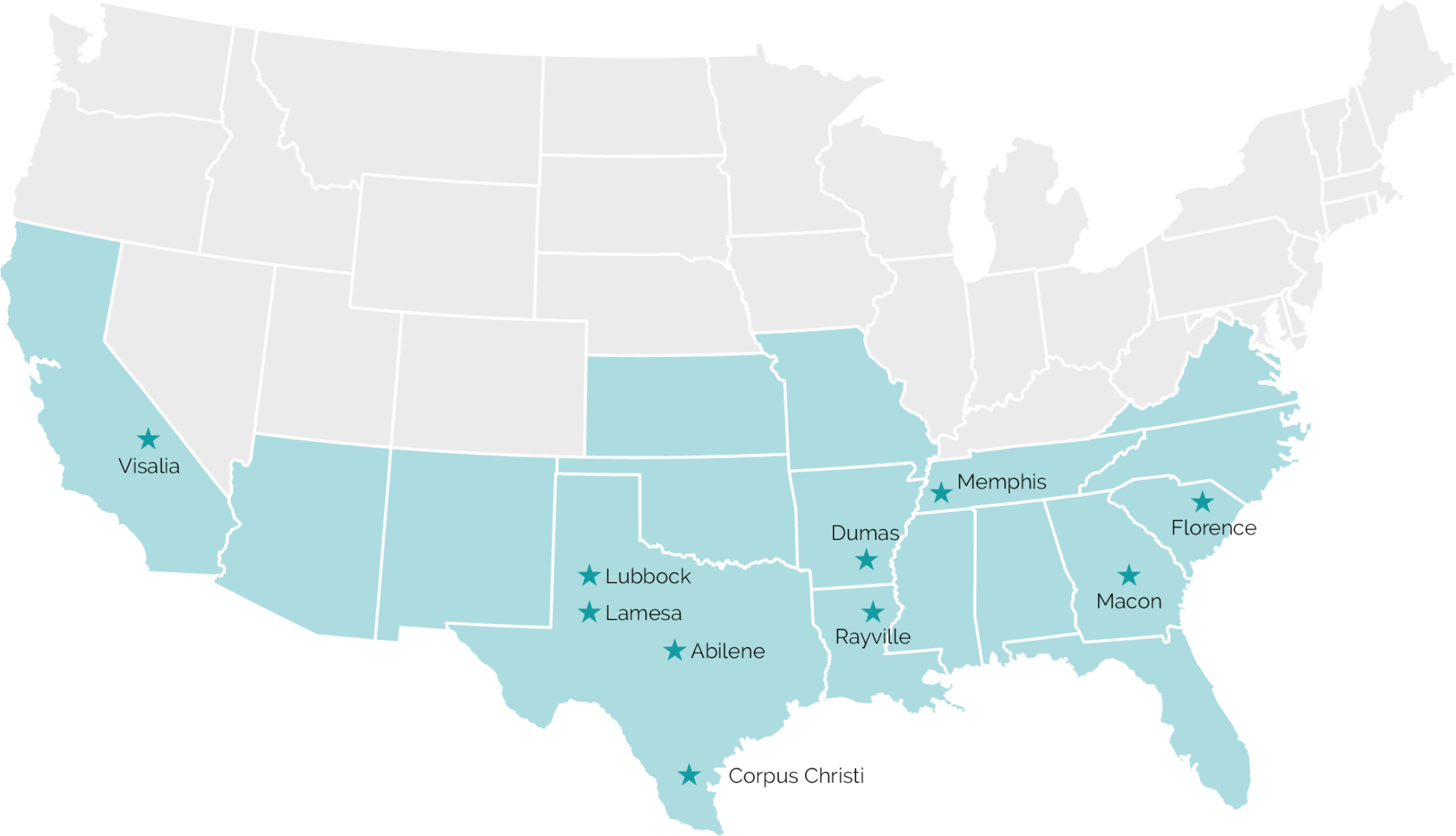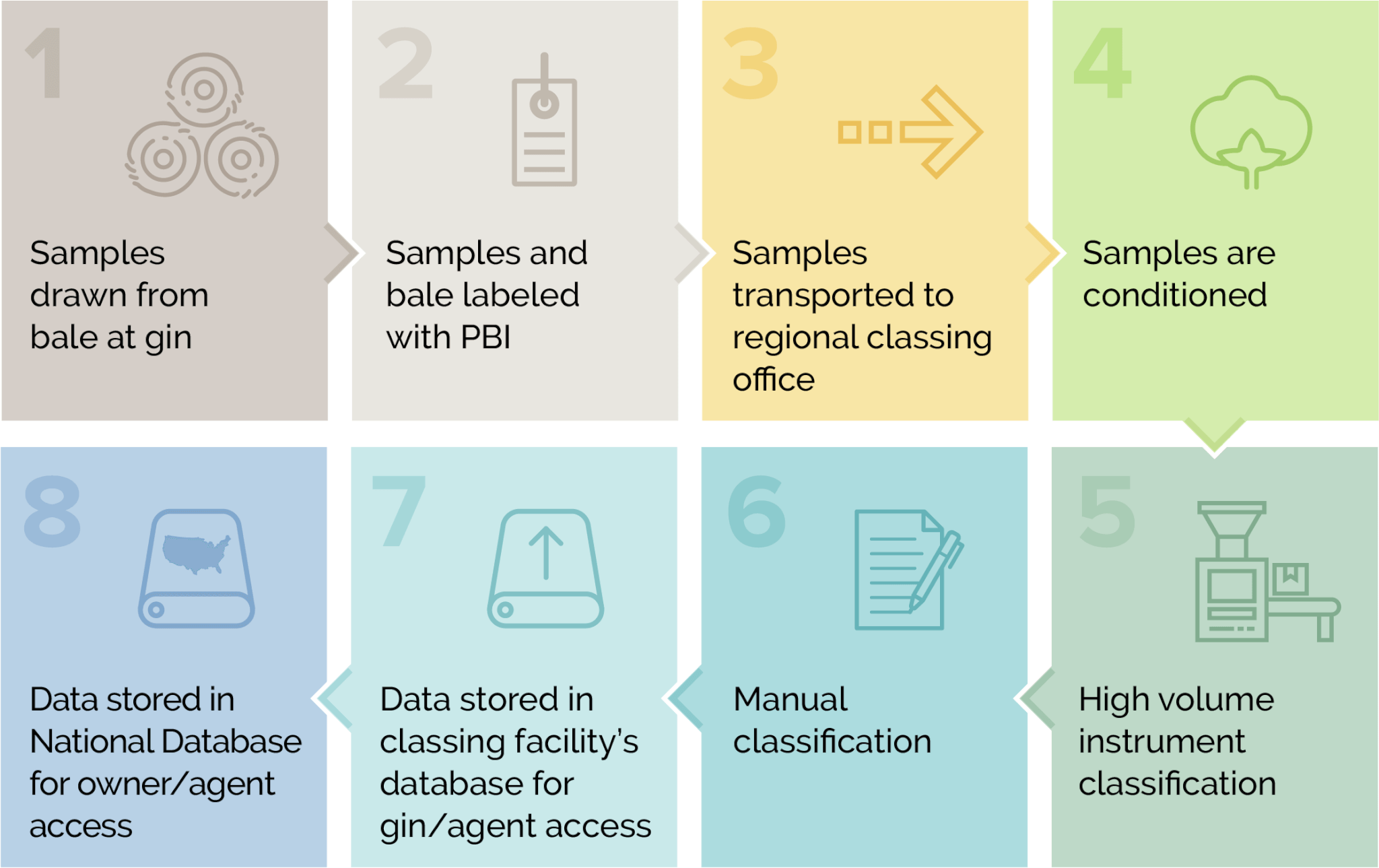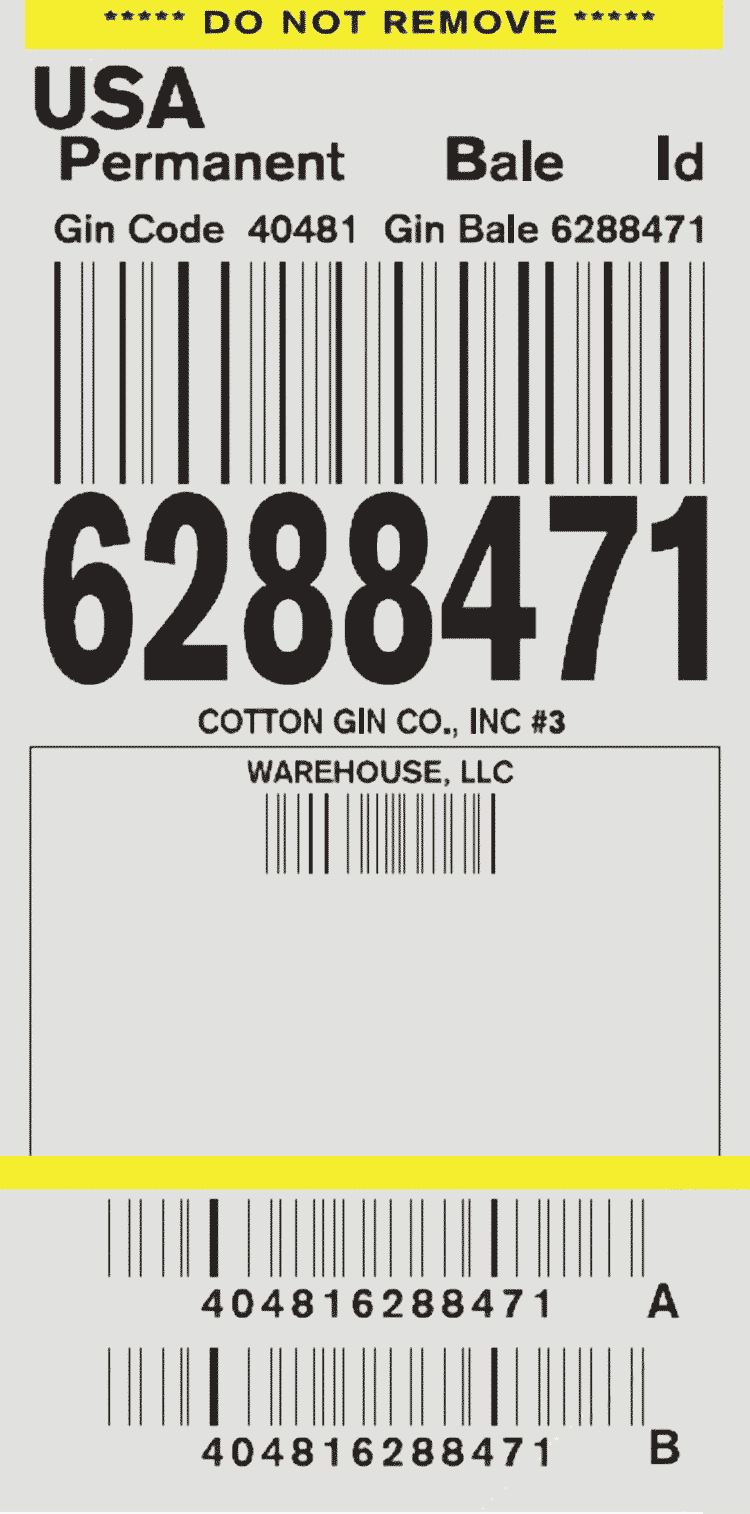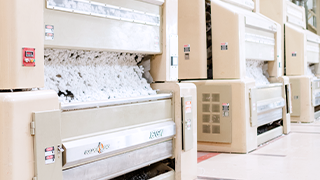Cotton Classification
USDA Cotton Classing
Cotton classification refers to the application of official standards and standardized procedures developed by USDA for measuring the physical attributes of raw cotton that affect the quality of the finished product and/or manufacturing efficiency.
The USDA classing methodology is based on grade and instrument standards, and it’s used hand in hand with state-of-the-art methods and equipment. The resulting information provides the cotton industry with the best possible data on cotton quality for the purposes of accurate marketing and processing. USDA classification currently consists of determinations of fiber length, length uniformity, fiber strength, micronaire, color, trash, leaf, and extraneous matter.
Darryl Earnest of the USDA discusses how cotton is evaluated and classified in the United States as well as his division’s role in supporting U.S. cotton producers.
Today, precision instruments are used to perform quality measurements, and they’re able to do so in a matter of seconds, whereas original classification methodology systems were inefficient and relied on human senses. The classifications still done manually are for special conditions and extraneous matter. The USDA is in the process of transitioning to all-instrument classification as quickly as the technology can be developed, refined, and prove reliable results.
- Classification Structure
- Standards
- Classification of Upland & Pima Cotton
- Quality & Reliability of Classification Data
- Dissemination of Data
Classification Structure
The USDA provides cotton classification services under the direction of the Agricultural Marketing Service (AMS) Cotton and Tobacco Program, which has eight main areas of operation. Each division plays an integral role in maintaining a reliable, efficient, and effective classification system and delivery of services.
AMS Divisions
- Grading
- Standardization and Engineering
- Quality Assurance
- Market News
- Information Technology
- Research and Promotion Staff
- Administrative Staff
- Program Appraisal Staff
Scope
U.S. cotton producers have requested that the majority of all cotton grown in the country is classed by USDA. And although classification is not mandatory, growers have found that it’s an essential piece of the marketing puzzle and necessary for their participation in the USDA price support program.

The USDA AMS Cotton and Tobacco Program operates ten cotton classing facilities across the Cotton Belt (locations shown on the map above). These facilities, which are part of the Grading Division, are designed specifically for cotton classification and are staffed exclusively with USDA personnel.
The USDA classes all cotton tendered for delivery on future contracts on the Intercontinental Exchange and provides arbitration classing to the industry. These services are performed by the Quality Assurance Division and are provided to individual manufacturers, breeders, researchers, and others, upon request.

Process
After cotton fibers are separated from the seed at the gin, cleaned to remove plant residue and foreign material, and pressed into bales, a sample is taken. A licensed sampling agent takes a sample of at least 4 oz. from each side of every 500 lb. bale and identifies each one with a Permanent Bale Identification (PBI) tag. Afterward, the samples are delivered by the agent or designated hauler to the USDA classing facility serving the area.
Upon arrival at the classing office, cotton samples are placed into a climate-controlled room where the moisture content of samples is brought into a specified range. This process ensures that the variability of samples is reduced and the classification process fair and equal. After samples are equalized, they’re transported to the instrument-testing and manual-classing stations where classification is performed.

Once classification is complete, results are immediately imported into the classing facility’s database and made available to the customer. Then, at the gin, each bale is labeled with a PBI tag, which includes a twelve-digit number and barcode identifying the classing office, gin, and bale. Each ID number is logged into a database.
Tracking
The PBI system is part of cotton’s traceability journey, allowing it to be tracked from the gin to the classing office. At the gin, each bale is labeled with a PBI tag with a twelve-digit number and barcode identifying the classing office, gin, and bale. Samples taken at the gin for classing are also labeled with PBI tags.
The PBI tag follows each cotton sample through testing at the classing office. The results are linked to the bale and stored in the USDA AMS Cotton and Tobacco Program’s National Database by PBI number. This data can only be accessed by either the owner of the cotton or the owner’s authorized agent.
Standards
Official standards and standardized procedures have been developed to maintain the integrity of the USDA classification system. Official standards are maintained and provided by the Cotton and Tobacco Program’s Standardization and Engineering Division. The USDA maintains two basic types of standards—grade standards and instrument standards.
Grade Standards
Grade standards, used for manual classification, specify levels of color and leaf for various grade designations. The USDA maintains two types of grade standards—Universal Upland Grade Standards (referred to as “Universal” standards) and American Pima Grade Standards.

Both Universal Upland and American Pima Grade Standards are only valid for one year because of the gradual changes in color as cotton ages. Grade standards for both American Upland and American Pima Cotton are reviewed periodically to ensure they are still representative of the U.S. crop.
Instrument Standards
Cotton instrument standards are used for instrument calibration and verification. These standards include Universal HVI Calibration cotton, Extra-Long Staple (ELS) Calibration cotton, Universal HVI Micronaire Calibration cotton, Universal HVI Cotton Color, and Cotton Trash Standards.

Establishing Values for Calibration Cotton
In addition to bale uniformity requirements, each bale must meet the length and strength criteria for its intended use. Currently, seven laboratories work together to establish values for calibration cottons, including five USDA facilities, one independent laboratory in the U.S., and one in the international community. Cumulatively, the labs perform at least 120 tests per bale over a two-day testing period, and the results are used to further evaluate uniformity and to determine the values assigned to the calibration cottons.
For reference purposes, samples of previously established (“benchmark”) calibration cottons provide reference points to assure the continuity of testing levels over time.
Classification of Upland & Pima Cotton
The classification of Upland cotton includes measurements for fiber length, length uniformity, fiber strength, micronaire, color grade, trash, and leaf grade. They are performed by precise High Volume Instruments, in a process commonly referred to as “high volume instrument classification.” Only extraneous matter and special conditions are still officially classified by the traditional method of classer determination.
Classification procedures for American Pima cotton are similar, including the use of high-volume instrument measurements. The most significant distinction is the difference in color charts. Different grade standards are used because American Pima cotton is naturally a deeper yellow than American Upland cotton.
Pima cotton is roller ginned and Upland cotton is saw ginned. Saw ginning results in a smoother appearance and you can get additional details about the differences in our Cotton Classing Booklet.
Quality & Reliability of Classification Data
The monitoring of quality is performed mainly through the operations of the Cotton and Tobacco Program’s Quality Assurance Division. Several tools and programs such as laboratory conditioning, sample conditioning, equipment performance specifications, instrument calibration, in-house monitoring, and the USDA’s Quality Management Program, are in place to manage quality.
Laboratory Conditioning
In order to ensure atmospheric conditions don’t influence the measurement of cotton fiber properties, the temperature and humidity of the classing laboratory are tightly controlled.
Sample Conditioning
Samples are conditioned to bring the moisture content into equilibrium with the approved atmospheric conditions. The conditioned samples are randomly checked to verify that the appropriate moisture content has been reached. Samples may be conditioned passively or actively.
In passive conditioning, the samples are placed in single layers in trays with perforated bottoms to allow the free circulation of air. In active conditioning, a Rapid Conditioning unit is used to draw air (set at the approved atmospheric conditions) through the sample until the required moisture content for high volume instrument testing is attained.

Equipment Performance Specifications
It’s essential to verify that classing equipment meets minimum performance specifications for precision and accuracy. Newly purchased equipment must pass a series of thorough tests before being accepted and put into operation. Additionally, all instruments are evaluated annually, typically before the beginning of each cotton season. Testing is done to verify both the precision and the accuracy of instrument measurements.
Calibration of Instruments
Instrument calibration is performed at regular intervals for each quality—fiber length, length uniformity, micronaire, and fiber strength—through the use of calibration cottons. Tiles are used to calibrate color and trash measurements.
Quality Management Program
The USDA’s Quality Management Program (QMP) ensures that all USDA classification facilities across the Cotton Belt provide uniform test results.

QMP utilizes a series of known value cottons and tile materials that are tested every two hours to verify cotton measurement levels and results of the QMP verifications are analyzed and graphed utilizing specialized data analytics programs. In addition to two-hour checks, special USDA round test samples are tested weekly to further verify that instrument test levels are consistent between all USDA classification facilities.
Dissemination of Data
USDA Data Dissemination
The USDA disseminates data in two formats—official classification information and statistical information regarding quality, volume, and pricing. Dissemination of classification data is managed by the cotton and Tobacco Program’s Information Technology Division.
Cotton classification data is imported into the Cotton and Tobacco Program’s National Database and contains classification data for the current crop as well as the crops for the past four years.
The Cotton and Tobacco Program’s Market News Division publishes daily, weekly, monthly and annual reports on crop quality statistics for both Upland and American Pima cotton. The reports include the number of bales classed and the distributions of color grade, leaf grade, staple length, micronaire, fiber strength, length uniformity, extraneous matter, and high volume instrument trash.
Cotton Incorporated’s Cotton Resource Management Tools
Cotton Incorporated’s Engineered Fiber Selection® (EFS®) Cotton Management System™️ software allows the industry to use cotton classing data to consistently create the best-quality yarn.
MILLNet™️ software enables mills to easily manage the natural variables of cotton to produce consistent and uniform laydowns. As a result, the mill has the potential to produce higher-quality yarn and fabric, reduce overhead costs and increase productivity with a seamless flow of data from cotton buyers to sellers.
EFS® – USCROP™️ software offers cotton buyers a tool to make informed purchasing decisions by providing the data for the entire U.S. crop week-by-week during ginning season. Users have the ability to view the U.S. cotton crop by selecting the specific fiber properties and ranges desired.
The United States classes 100% of its bales and makes this data available to all U.S. cotton users. The fiber quality data associated with the bales ensures cotton buyers that they are buying the appropriate cotton quality for the product they plan to manufacture. The PBI labels that travel with bales through the classing office give buyers the confidence of traceability.
To learn more, download our Cotton Classification Booklet.
More on Fiber Science
- Sourcing Cotton: How Fiber Quality Impacts Your End Product
- Natural vs. Synthetic Fibers: Classification, Qualities, & Life Cycle
- Cotton Fiber Development & Maturation
- Cotton Fiber: Harvesting & Ginning
- Cotton Fiber Qualities & Evaluation


